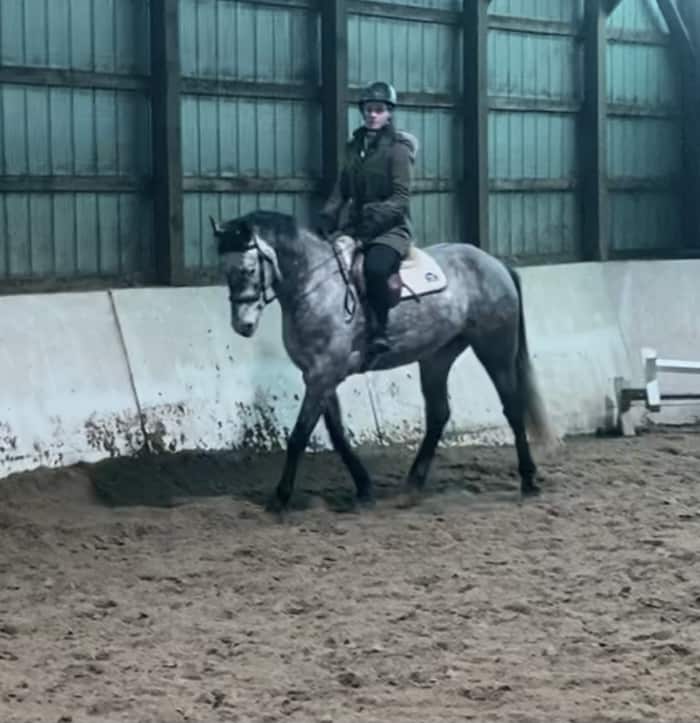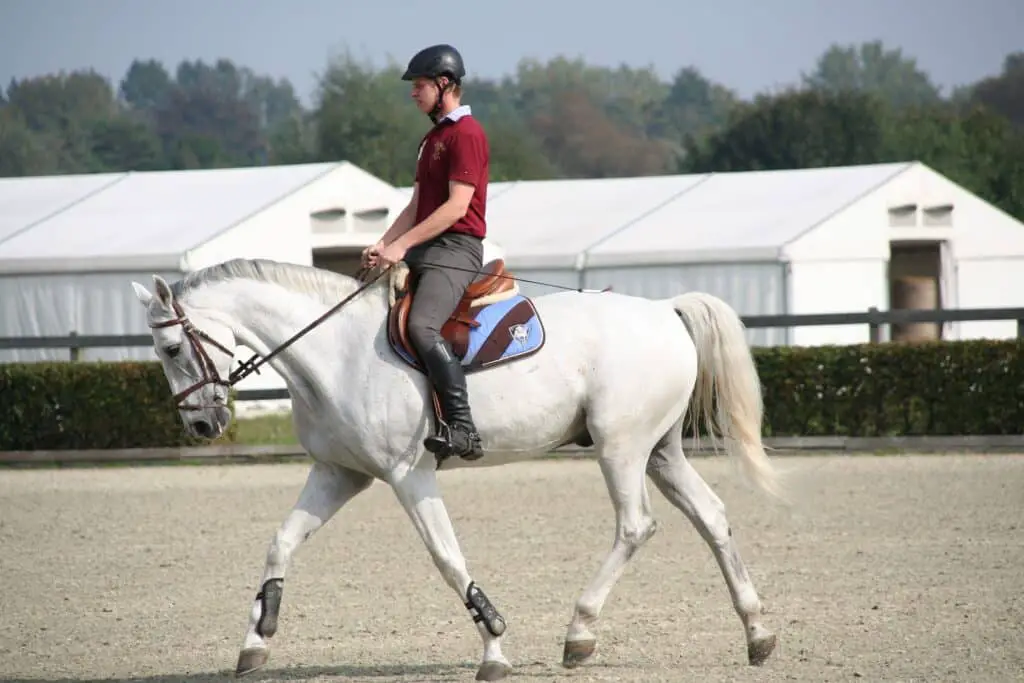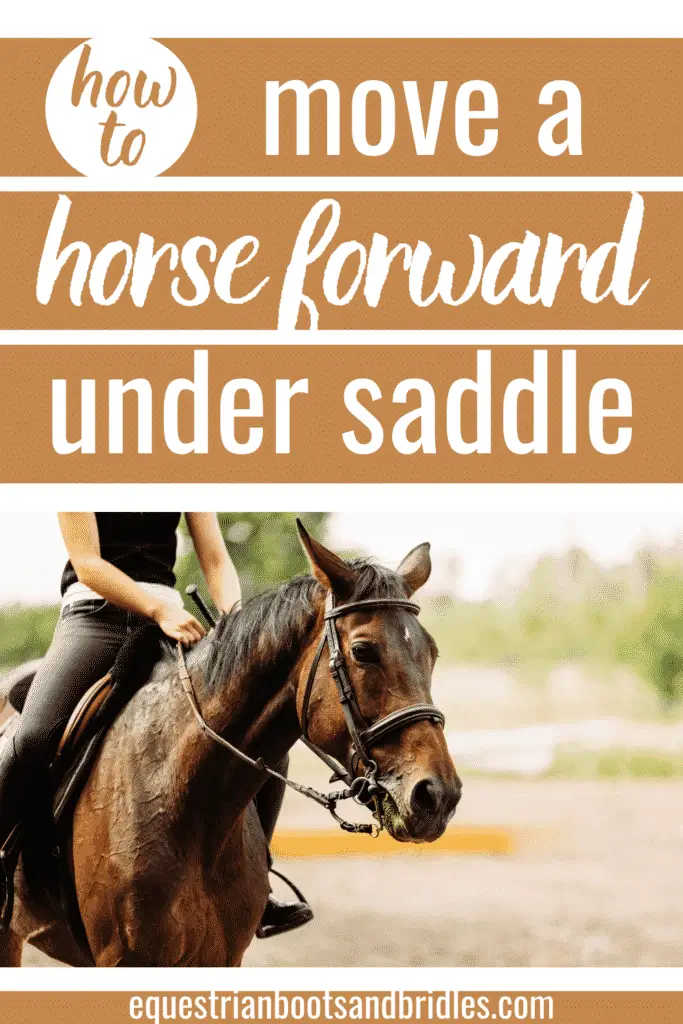Have you ever had trouble trying to move a horse forward under saddle?

Example
You’re riding a school horse around the arena at a trot on the right lead. Every time you pass a corner, you put on the correct canter aids.
Your outside leg comes back behind the girth. Your inside leg stays at the girth. You sit and squeeze both legs together.
The horse’s trot picks up slightly but he doesn’t break into a canter. After the 4th or 5th time, you give up because your bum is getting sore from sitting in this quickening trot and you need to collect your bearings since your feet are way too far forwards in the stirrups after bouncing around so much.
After resting a little bit at the walk, you start trotting again. This time, your instructor is waiting up by the next corner. You do all the same aids but this time your instructor clucks and brings her body energy up as the horse comes by.
The horse immediately breaks into a canter as he passes by her. He holds the canter for about half the arena and then he spontaneously comes back down into a trot despite the fact that you tried to put on leg as soon as you felt him slow and that you were using your seat properly to keep him cantering.

Moving Satchmo Forward Under Saddle
The very first horse I rode was called Satchmo, named after Louis Armstrong. He was an all black, fiesty little pony and my absolute favourite and I essentially held a monopoly on him for years until I outgrew him given he was a pony. No one else rode him at that barn except for me. I was there often enough that worked out well.
My Dad would get so annoyed at me because we lived in the city. That meant he was routinely driving me 35-45 minutes each way to the barn and I would beg to go literally every day.
All of my firsts were on Satchmo:
- first walk, trot, canter
- first trail tride
- first jumps
- first jumping course
- first jumping competition
- first horsemanship test
- first time going bareback
- first time going bridleless
- first going bareback & bridleless!
Eventually it got to the point where we were such a good team, we knew each other inside and out.
The thing with Satchmo is that he HATED leading. This was a huge issue I had to overcome and it took me over a year to fully get over it. So whenever we were in a group lesson or a trail ride, he was perfect going forwards as long as he was following after another horse. If he was at the front, you could forget it.
You might be thinking, “Isn’t that a problem with leading?” And it is. But it’s more fundamentally a problem of going forwards under saddle. If he responded to my cue of going forwards under saddle then he could do that from no matter where he was with respect to other horses.
The Biggest Mistake I Made
The mistake I made and I see a ton of people make to this day is that I didn’t follow through.
Essentially what would happen is that Satchmo would inevitably have to lead at one point or another. When that would happen, I could hardly get him to pick up a brisk walk let alone anything else. Furthermore, every second of that walk was agonizing. I was constantly squeezing and kicking and clucking.
The problem though was that I would tire out! I mean obviously, who wouldn’t?
No one can keep up that amount of effort for very long.
So, what did Satchmo learn?
If he walks slowly for approximately 1-2 minutes, all the pressure of me kicking and squeezing and moving around on him stops. Therefore all he has to do is walk for that amount of time and everything is fine with the world! The best part? Then I take him back behind another horse so that he can follow again and he’s even happier because he gets to be in his comfort zone again.
So what did I do? How did I make him move forwards?
I learned to only ask once and then escalate pressure quickly and firmly until he up-transitioned. The second he did that, I removed ALL pressure. Only if he came back down to a walk, did I restart the cycle.
The important part is to be very clear, firm and decisive.
Avoid doing this: click, cluck, squeeze, rest, kick-kick, cluck-cluck, rest, squeeze, squeeze, move your body around, rest, kick, cluck-cluck, etc. That is super confusing and becomes just noise the horse learns to tune out.
Especially avoid doing this: continuing to apply pressure when the horse starts to trot. I don’t care if it’s the slowest, laziest trot in the whole world. You want to let that horse know that he did good by trotting. If he comes back to a walk, then you apply pressure again but right now, we’re rewarding ANY trot, even the worst trot in the world!
The Tricks to Move A Horse Forward Under Saddle
Let’s go through what you’re going to do now step-by-step…
First, it’s important to recognize that as you’re trying to move a horse forward under saddle, the horse is actively asking you at that moment: “Do I really have to trot right now?”
If you have the ability and the willingness to back up your trot request, then your answer is going to be: “Absolutely you have to trot.”
So what you’re going to do in this situation is the following:
#1. Ask the horse to trot with by squeezing your legs, your seat and your increased energy. You can even cluck once to give additional encouragement.
#2. If you get no response, you’re going to keep the pressure on with your legs, you’re going to keep your seat asking and you’re going to immediately give ONE tap on the horse’s inside shoulder with the crop. It doesn’t have to be hard or anything. But it has to be very quickly after you’ve asked with your legs.
#3. If you still get no response, you’re going to keep the pressure on with your legs, you’re going to keep your seat asking and you’re going to give ONE tap on the horse’s hindquarters with the crop immediately after.
#4. If even now you get no response, you’re going to immediately after tap ONE time again on the hindquarters combined with a kick.
That is your escalation. That’s it!
And remember that as SOON AS HE TROTS, you do nothing. Just completely relax and make it super easy for him to keep trotting.
If you get to #4 and you still don’t get a trot, then unfortunately it’s time to go back to groundwork as the horse has a lack of understanding of the fundamentals.
A good trick is to ride in a round pen or on a lunge line with someone on the ground. Then you slowly transition the cues from the person on the ground asking for forward motion to the cues from the rider.
Let me know if this helps you out, and if you’re now able to move a horse forward under saddle!
What about if you’re having the opposite problem and you’ve got a horse that won’t slow down? Have a read of this guide!
Liked this post? Why not pin it?


